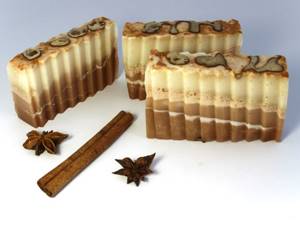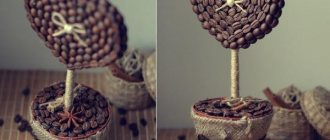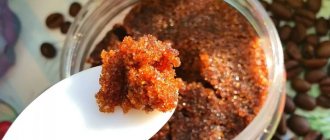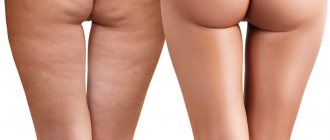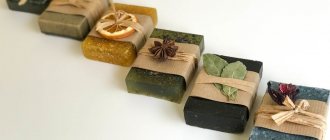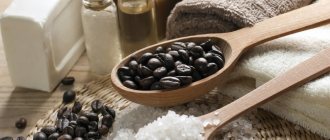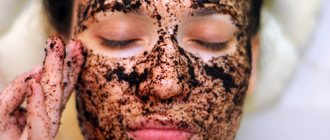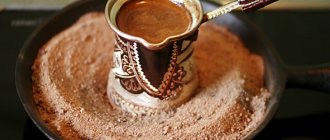Beneficial properties of coffee scrub soap
Cosmetics made in production contain chemical components, while homemade cosmetics are environmentally friendly and safe. Coffee scrub soap has the following positive properties:
- homemade soap is much cheaper than popular body and face care products. The ingredients used in home soap making are not expensive at all;
- The components of a home remedy are quite accessible to everyone. The necessary ingredients are sold in stores or grown in the garden, in the forest, in the garden;
- using scrub soap helps to effectively cleanse the skin by removing dead epidermal cells;
- During scrubbing, the skin is saturated with beneficial vitamins, minerals, and oils;
- In the process of making soap based on ground grains, only natural ingredients are used, so this cosmetic product is considered absolutely safe.
To make soap a coffee scrub, coffee particles are added to it, which contain a whole range of beneficial substances. Homemade scrub soap helps speed up blood circulation, activate metabolic processes in the body, and remove toxic contaminants. Coffee is often used to combat excess weight and cellulite.
Useful characteristics of coffee scrub soap
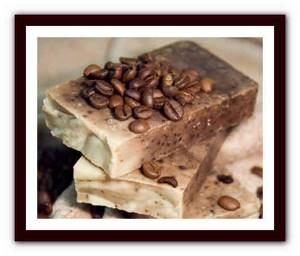
Cosmetics produced in production contain chemical components, while homemade cosmetics are environmentally friendly and safe. Coffee scrub soap has the following positive characteristics:
- homemade soap is significantly cheaper than popular body and face care products. The ingredients used in home soap making are not at all inexpensive,
- The components of a home remedy are completely accessible to everyone. The necessary ingredients are sold in stores or grown in the garden, in the forest, in the garden,
- the use of scrub soap helps to perfectly cleanse the skin by removing dead epidermal cells,
- During the scrubbing process, the skin is saturated with beneficial vitamins, minerals, oils,
- In the process of making soap based on ground grains, only natural ingredients are used, therefore such a cosmetic product is considered completely non-hazardous.
To make soap a coffee scrub, coffee particles are added to it, which contain a whole range of necessary substances. Homemade scrub soap helps speed up blood circulation, activate metabolic processes in the body, and remove toxic contaminants. Coffee is often used to combat excess weight and cellulite.
Tips for choosing ingredients
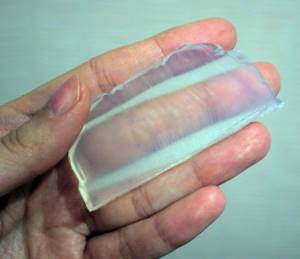
Homemade scrub soap includes the following ingredients:
- Transparent base. Most often it is bought in specialized departments of stores, but you can make the base yourself using glycerin, alkali with water and oils. Of course, it is better to prepare a transparent base yourself, but it is difficult for novice soap makers to follow the exact recipe. In order to make the base correctly, you need to monitor the weight of each ingredient, temperature, and correct proportions.
- Homemade soap is often made with the addition of scrubbing particles, which help exfoliate the top layer of the epidermis. For these purposes, various products are used: ground oatmeal, semolina, millet, zest, dried plants, but the best option is considered to be natural ground coffee.
- Essential oil. Citrus oils, ylang-ylang, patchouli, lemon balm, mint and others are often added to cosmetic home remedies.
- The cosmetic product contains base oils that make the skin softer and smoother. In addition, oils prevent the finished cosmetic product from cracking and falling apart. The composition may include body milk, cream, full-fat milk, cream.
Base for making homemade soap
Various soap base manufacturers offer a wide range of their products. The basics differ according to the following criteria:
- price;
- hardening speed;
- hardness.
Specialized stores offer organic bases that allow you to make a completely environmentally friendly product.
Many soap makers use baby soap that does not contain fragrance. The block is grated with a grater, melted in a water bath and mixed with the rest of the ingredients.
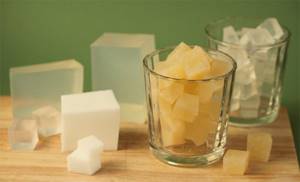
Soap base may vary
Which coffee will be more effective?
Only natural coffee is used in soap making. Soluble sublimate is absolutely useless, moreover, its chemical composition can negatively affect the condition of the skin. It is advisable to add medium grind coffee beans to soap that will be used on the body. For feet and hands, it is better to use a product with the addition of coarse grinding.
Possible additives
In addition to the main components, the following ingredients can be added to home cosmetics if desired:
- crushed oatmeal and almond seeds, coconut flakes, dried plants, citrus fruit zest;
- natural honey in liquid form, dark or milk chocolate, cocoa powder, dairy products;
- dyes (liquid or dry). Instead of ready-made dyes, many use natural products: turmeric, beet juice, curry;
- For decoration during the soap-making process, small sparkles and other decor are added.
How to make homemade scrub soap with your own hands - step-by-step instructions with photos
- Grate three 60-gram bars of baby soap on a medium grater. Pour the shavings into a container and heat in a water bath.
- Pour in 20 grams of oil, start stirring , evenly adding half a glass of boiled water in small portions to prevent the formation of clots and foam.
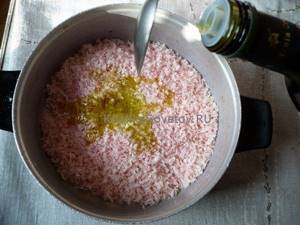
- After a few minutes, a plastic mass of a homogeneous structure is obtained - this is our basis.
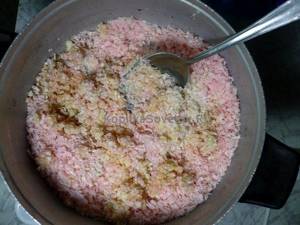
- Sea salt and coffee will give an anti-cellulite effect.

- For the proposed volume of soap base, 3-4 tablespoons of ingredients will be enough. You can add these components immediately, stirring thoroughly for three minutes.
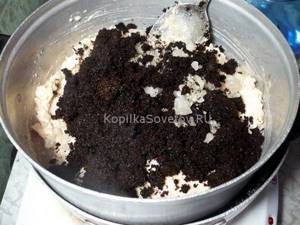
- You should not add more salt and coffee than normal , otherwise the soap will not lather well, will separate into pieces and will not be dense enough.
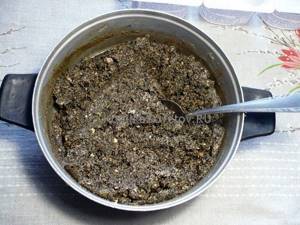
- Fill the greased molds with the resulting mixture, carefully sealing. After 3 days, the soap can be removed from the molds. It should be homogeneous, dense and dry.
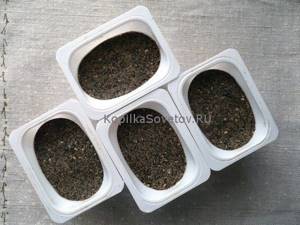
Our scrub soap is ready! Have a nice creative process!
How to make coffee scrub soap on video
Necessary equipment
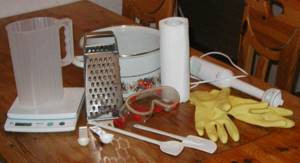
The production of a handmade cosmetic product is impossible without special equipment. You will need the following:
- Enameled pan (stainless steel is also suitable).
- Larger container (needed to make a water bath).
- Container made of plastic or glass.
- Whisk, measuring cup, spoons.
- Accurate kitchen scales (electronic).
- Spray.
- Various shapes for the final product.
Step-by-step instructions for making scrub soap with coffee
To make your own homemade coffee scrub soap, prepare the following:
- clear soap base or baby soap (unscented);
- a couple of tablespoons of extra virgin olive oil;
- ground coffee (you can use coffee grounds);
- boiled water;
- sea salt.
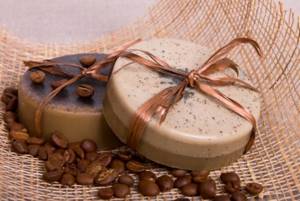
Let's start the soap making process:
- If you have little experience in home soap making, it is better to use regular baby soap as a base. Take 3 pieces (about 60 grams each), grate them on a medium grater. Place the resulting soap shavings in a saucepan and place in a water bath.
- Pour oil into the pan. Stirring continuously, pour in water in a thin stream, avoiding the formation of foam and lumps.
- When the mass becomes uniform in consistency, thick and dense, add salt and coffee (2 tablespoons each) to the pan.
- Grease the selected molds in advance. Fill them with the resulting mass, compacting thoroughly. Leave for 3 days to harden.
On a note! You should not add large amounts of coffee and other scrubbing additives. The soap may begin to delaminate, crumble, and lose its shape.
Step-by-step instructions for making scrub soap with coffee
To make your own homemade coffee scrub soap, prepare the following:
- clear soap base or baby soap (fragrance-free),
- a couple of tablespoons of extra virgin olive oil,
- ground coffee (you can use coffee grounds),
- boiled water,
- sea salt.
Let's start the soap making process:
- If you don’t have enough experience in home soap making, it is better to use ordinary baby soap as a base. Take 3 pieces (approximately 60 grams each), grate them on a medium grater. Place the resulting soap shavings in a saucepan and place in a water bath.
- Pour oil into the pan. Stirring continuously, pour in water in a narrow stream, avoiding the formation of foam and lumps.
- When the mixture becomes a homogeneous mixture, thick and compacted, add salt and coffee (2 tablespoons each) to the pan.
- Grease your chosen molds in advance. Fill them with the resulting mass, carefully compacting them. Leave for 3 days to harden.
On a note! It is not recommended to add large amounts of coffee and other scrubbing additives. The soap may begin to delaminate, crumble, and lose its shape.
How to give soap an unusual shape
Those involved in home soap making pay special attention to the shape of the product. Everyone wants to end up with not a shapeless piece of soap, but an exclusive product with an unusual shape. For this purpose, special molds of a wide variety of shapes are used. The choice of molds is huge: animals, plants, geometric shapes, food, flowers. Instead of special molds for home soap making, you can take baking molds or even children's molds from sand sets. As for the material, it is preferable to choose a mold made of silicone or plastic. Rubber options are also suitable. It is better not to use glass and ceramics, because it is extremely difficult to get the soap mass out of such forms.
Important! The use of iron products is strictly prohibited, as an unexpected chemical reaction may occur during which the product will become hazardous to health.
How to give soap an unusual shape
Those who make home soaps pay increased attention to the shape of the product. Everyone ultimately wants to receive not an incomprehensible piece of soap, but an exclusive item of unusual shape. For this purpose, special molds of various shapes are used. The choice of molds is large: animals, plants, geometric shapes, food, flowers. Instead of special molds for home soap making, you can take baking molds or even children's molds from sand sets. As for the material, it is better to choose a mold made of silicone or plastic. Rubber options are also suitable. It is better not to use glass and ceramics, because it is very difficult to get soap mass out of such forms.
Fundamentally! It is strictly forbidden to use steel products, as an unexpected chemical reaction may occur, during which the product will become unsafe for health.
Recipes for coffee scrub soap with various additives
Banana paradise
For banana scented scrub soap you will need:
- ripe banana;
- half a glass of natural yogurt without sugar and fruit fillers;
- ground coffee - one and a half spoons;
- half a glass of clean water;
- one and a half tablespoons of oil (preferably olive);
- 1 bar of baby soap;
- 2 drops vanilla aromatic oil.
Let's start preparing “banana heaven”:
- Pour boiling water over the coffee powder and leave to steep for an hour.
- Mash the banana and grate the soap using a grater.
- Mix banana puree, natural yogurt, olive oil, soap shavings and coffee liquid (without grounds). Heat the saucepan with the mixture over low heat for five minutes.
- Remove the pan from the stove, close the lid, and leave for 30 minutes.
- When the mixture in the saucepan has cooled, add coffee grounds and vanilla oil.
- Mix everything well and place in prepared molds. After 2-3 days, the banana scrub product will be ready.
The soap has exfoliating, moisturizing effects, nourishes and restores the skin.
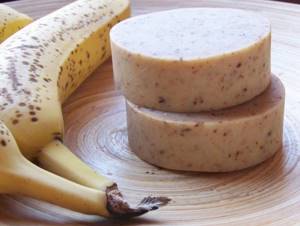
Coffee soap with honey and cocoa butter
- Melt baby soap, grated or very finely chopped. Be sure to stir the mixture with a wooden spatula so that it does not burn.
- Add a tablespoon of liquid honey to the saucepan, stir and wait until the honey-soap mixture melts until smooth. Do not bring to a boil!
- Remove the pan from the stove, pour in a spoonful of butter (the recipe suggests using cocoa butter).
- If desired, you can add any aromatic fragrances for a pleasant smell.
- Grease the molds with oil and pour the soap solution into them. Sprinkle ground coffee on top, which, as it hardens, will be evenly distributed throughout the entire soap bar.
- Gently stir the contents of the molds with a wooden spatula.
- Let the molds harden. When the mass hardens, carefully remove the finished product.
Coffee soap with cocoa nourishes the skin, saturates it with essential microelements, while gently exfoliating the dead upper layer of the epidermis.
